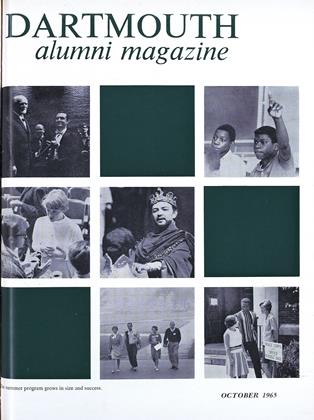By Merle Curti and Prof. Roderick Nash(History). New Brunswick, N. J.: RutgersUniversity Press, 1965. 340 pp. $8.50.
As the title suggests, this book explores the extent to which philanthropists contributed ideas as well as money to the development of higher education. Their conclusion is that "The American experience demonstrates that private gifts and bequests have been vital in the continual reshaping that has marked the development of colleges and universities. Too often ideas alone are given credit as the moving force in history without recognition of the crucial role of material resources in transforming abstractions into realities. Of course ideas are indispensable, and so is leadership, but without money the necessary impetus for innovation is often lacking."
In reaching this conclusion they examine decisive gifts or philanthropic programs from 1638 to today and from many types of donors. Illustrations are cited involving almost 200 institutions.
The analysis follows an historical pattern first from Harvard and the colonial colleges, through the great growth of new institutions as the nation expanded westward. A particularly interesting chapter deals with the rise of "a practical higher education" in reference to the needs of an industrial society and the convictions of the self-made men who became the great philanthropists of the latter half of the 19th Century.
Later chapters deal with special fields of philanthropy, such as education for women and Negroes, and with major sources of funds such as alumni, foundations, and corporations.
Occasional errors of fact mar the book, such as a reference to Dartmouth College moving from Lebanon, Connecticut, to New Hampshire and the statement that General Motors started the matching gift form of corporate support.
Some unsupported conclusions raise questions such as this summation of foundation influence: "From the standpoint of the shaping of American higher education, foundation philanthropy's principal importance has been helping to make the college or university a center for research and advanced study." No statistics are supplied and the illustrations offered do not entirely support this proposition.
Certain inconsistencies between chapters are interesting. In summing up corporate support it is stated that giving went primarily to conventional and traditional programs. "Conservatism apparently dominated the philanthropy of American business men as it did their politics. Like most of those who supported the colonial colleges, corporations in the twentieth century seemed to regard having a system of diversified education as more important than the shape it assumed." A few pages later, but in another chapter, it is stated, "The association of a philanthropist with a college or university proved to be both a great asset and a serious liability, depending in large part on his attitude as a donor and on his ability to work with educational leaders and experts. The optimum relationship seems over the years to have been one in which the donor gave little but his money."
In spite of such items, the book justifies its authors' statement: "We used broad strokes to paint the main patterns of its [philanthropy's] relation to higher education over the entire course of American history."
Director of Development
 View Full Issue
View Full Issue
More From This Issue
-
 Feature
FeatureThe Wheelock Dream, Sparsely Realized, Is Still a Force in the Life of the College
October 1965 By JOHN HURD '21 -
 Feature
FeatureA Good Summer Press
October 1965 -
 Feature
FeatureSUMMER TEMPO IS GO-GO-GO
October 1965 -
 Feature
FeatureNewly Elected Members of the Alumni Council
October 1965 -
 Article
ArticleWith the Big Green Teams
October 1965 By ERNIE ROBERTS -
 Article
ArticleHow the "Big" Was Added to Green
October 1965 By W. HUSTON LILLARD '05
GEORGE H. COLTON '35
-
 Article
ArticleThe "Secret" of Success
December 1950 By GEORGE H. COLTON '35 -
 Article
ArticleAlumni Fund Launches 37th Annual Campaign
April 1951 By GEORGE H. COLTON '35 -
 Feature
FeatureNine-Man Council Charts Course for Development
January 1954 By GEORGE H. COLTON '35 -
 Feature
Feature"The Working of the Religious Element"
October 1954 By GEORGE H. COLTON '35 -
 Books
BooksFIGHTING YANKEE.
March 1956 By GEORGE H. COLTON '35 -
 Books
BooksA PART OF THE MAIN: SHORT STORIES OF THE MAINE COAST,
October 1973 By GEORGE H. COLTON '35
Books
-
 Books
BooksTHE KING'S STILTS
January 1940 By Alexander Laing '25 -
 Books
BooksDARTMOUTH VERSE—1930
DECEMBER 1930 By C. Dean Chamberlin -
 Books
BooksTWENTY MODERN AMERICANS
April 1943 By Herbert F. West '22 -
 Books
BooksProselytizers and Profiteers
May 1977 By LEO SPITZER -
 Books
BooksCONCERNING JUVENILE DELINQUENCY
January 1943 By R. P. Holben -
 Books
BooksCHINESE INFLUENCE ON EUROPEAN GARDEN STRUCTURES
April 1937 By Walter Curt berhrendt

